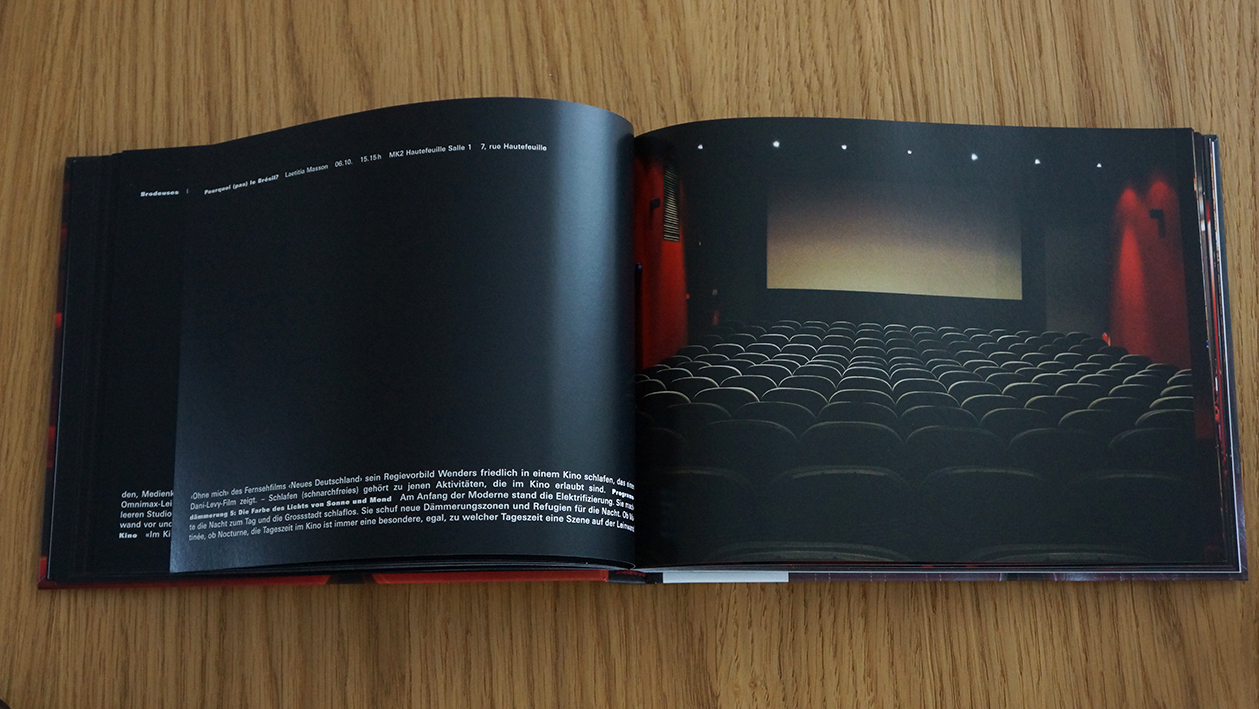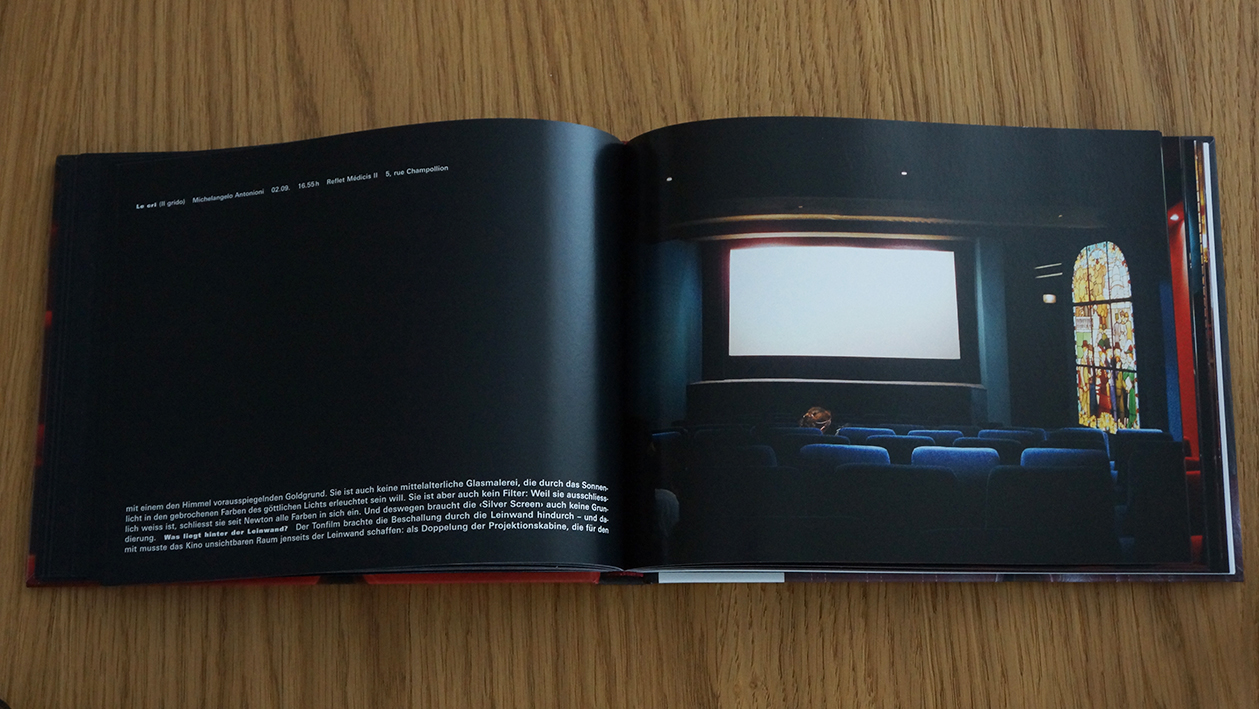Les Visiteurs du Soir
2007, Photography book
160 pages, 70 images, padded hardcover, 21,5 x 16,5 cm (texts: Hansmartin Siegrist; design: Dieter Bopp/hartmannbopp; lithography: Thomas Dillier/bureaudillier; editor: Claus Donau; printed by: Offsetdruckerei Grammlich; publisher: Christoph Merian Verlag Basel, ISBN 978-3-85616-322-8

5 x 2 Cinq fois deux François Ozon 28.08. 17.55h Les Trois Luxembourg 67, rue Monsieur-le-Prince

Purquoi (pas) le Brésil? Laetitia Masson 06.10. 15.15h MK2 Hautefeuille Salle 1 7, rue Hautefeuille

Brodeuses Eléonore Faucher 25.11. 11.25h Saint-André-des-Arts II 12, rue Gît-le Cœur

La vie passionnée de Vincent van Gogh (Lust for Life) Vincente Minelli 06.12. 14.00h Mac-Mahon 5, av. Mac-Mahon

My architect: A Son’s Journey Nathaniel Kahn 02.11. 11.30h L’Arlequin Salle 2 76, rue de Rennes

Le cri (Il grido) Michealangelo Antonioni 02.09. 16.55h Reflet Medicis 3, rue Champollion

La porte du soleil (Bab el shams) Yousry Nasrallah 21.10. 16.10h Sept Parnassiens Salle 4 98, bd du Montparnasse

Une femme sus influence (A woman under influence) John Cassavetes..02.09. 11.10h Quartier Latin Salle 1 9, rue Champollion

Land of Plenty Wim Wenders 29.11. 17.40h Cinéma le Brady l’Albatros 39, bd du Strasbourg
«Die Geschichte begann im ‹Cinéma du Panthéon›, einem Pariser Programmkino unweit der Sorbonne. Ich schaute mir ‹Goodbye Dragon Inn› (Bu Sun) des taiwanesischen Regisseurs Tsai Ming-liang an, eine Hommage an die frühen Kinosäle seiner ehemaligen Heimat Malaysia. Ein japanischer Tourist flüchtet vor dem strömenden Regen in ein Palastkino, das gerade die letzte Vorstellung zeigt. Auf der Leinwand sieht man King Hus ‹Dragon Inn› (Long Men Ke Zhen), einen klassischen chinesischen Schwertkampffilm.» Bettina Grossenbacher (aus ihrem Vorwort zum Buch)
‹Les visiteurs du soir› ist ein Fotobuch der besonderen Art und eine Liebeserklärung an das Kino und die Kinostadt Paris. Das Ziel: Möglichst alle Programmkinos besuchen, kein Kino zweimal besuchen und keinen Film zweimal sehen. Die Bilderreise führt durch alle zwanzig Pariser Arrondissements und durch hundert Jahre Filmgeschichte. Wir lernen nüchterne Kinos kennen, aber auch skurrile, wie das einem asiatischen Tempel nachempfundene ‹La Pagode›. Im Mittelpunkt steht die Leinwand, aufgenommen kurz vor Beginn der Vorstellung – weiss, leer, bereit für die Geschichten. Die Bildlegenden berichten, was gleich im Kino gezeigt wird: Filmtitel, Regisseur/Regisseurin, Name, Adresse. Diese cineastische Reise wird begleitet von Texten des Medienwissenschaftlers Hansmartin Siegrist, der den Blick auf etwas lenkt, was Film-, Kino- und Apparatetheorien bisher wenig beachtet haben: die Projektionsfläche selbst.
“The story began at the 'Cinéma du Panthéon', a Parisian art house cinema not far from the Sorbonne. I was watching 'Goodbye Dragon Inn' (Bu Sun) by Taiwanese director Tsai Ming-liang, a homage to the early cinema halls of Malaysia, his former homeland. A Japanese tourist takes refuge from the pouring rain in a palace cinema which is showing its last performance.” Bettina Grossenbacher (from her foreword to the book)
“Les visiteurs du soir” is a special kind of book of photographs and a declaration of love to cinema and to the film city of Paris. The aim: To visit as many art cinemas as possible, not to visit any cinema twice, and not to watch any movie twice. The trip crosses all twenty Paris arrondissements as well as one hundred years of film history. We get to know new and sober cinemas, but we also visit quirky ones, like ‘La Pagoda’, a cinema imitating an Asian Temple. In the center of the picture, you see the screen shortly before the performance starts: white, empty, ready for the stories. The captures tell you what will be shown: film title, director, cinema’s name, address. The cinematic journey is accompanied by texts of media scientist Hansmartin Siegrist focusing what film, cinema and apparatus theories have neglected so far: the projection screen itself.